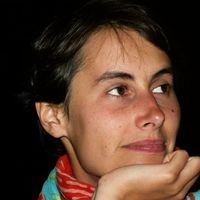
Ana Iuga
PhD: Camera imbracata taraneste pe Valea Izei. Dinamica obiceiurilor si a artei traditionale in Maramures / The Room Dressed in a Peasant Manner on Iza Valley. The Dinamic of Customs and Traditional Art in Maramures.
at Universitatea Babes-Bolyai, Facultatea de Litere, Cluj-Napoca
Supervisors: Prof. Dr. Univ. Ion Seuleanu
at Universitatea Babes-Bolyai, Facultatea de Litere, Cluj-Napoca
Supervisors: Prof. Dr. Univ. Ion Seuleanu
less
Related Authors
Paul Lane
University of Cambridge
Scott Madry
University of North Carolina at Chapel Hill
Bogdan Iancu
National University of Political Studies and Public Administration
Monica Stroe
National University of Political Studies and Public Administration
Ihor Bojko
Ethnology Institute of National Academy of Sciences of Ukraine
Bogdan-Vasile CIORUȚA
Technical University of Cluj-Napoca
Irina Ionescu
University of Arts Târgu Mureş
Viviana Ferrario
Università Iuav di Venezia
InterestsView All (16)










Uploads
Books by Ana Iuga
The book focuses on the “best room”, where the inhabitants of the Romanian villages place the most beautiful objects, mainly made by themselves. Here they put the dowry of the girls. This room is the festive space, the place where the human places himself away from all that means daily life and ordinary, the place where he is celebrating weddings, batism or important feasts.
The space of this room, researched in three communities on Iza Valley (department of Maramures), in Dragomiresti, Ieud and Salistea de Sus, is the starting point for the analyse of the dynamic of the culture, represented through traditional art (textiles made in the household) and customs (wedding customs). It is, on one hand, the analyse of the materiality of the festive space, the principles of organisation of the objects from the “best room” and the way in which they are influenced by the innerent dynamic of the rural world. A special attention is given to an ancien decorative element, the ruda, which still incorporates social, cultural and esthetical local values, still active for the people in the researched communities, even if, sometimes, on the point to be abandoned, and reinvented or invested with new meanings. On the other hand, another point of interest is represented by the ceremoniality that takes place in this space, how the festive room is used. The thesis is focusing on the wedding customs, seen in its special dynamic, influenced by the socio-cultural changes that occure. Through questioning the materiality and the ceremoniality of the “best room”, the thesis deals with the way that the space studied becomes a reference point for expressing the identity of the inhabitants of the three communities. For this, it was considered to be important the investigation of the context of creation of the space, the attitude of the creators and users of the festive space. In this way, it was possible to see that through the space, along with expressing the social position in a community, the people that were interviewed express themselves as continuators of the local tradition, or as people who renew and modify this tradition."
Volumul apare cu sprijinul financiar al CNCSIS, Grant tema „Vechi paradigme epistemice – Noi paradigme instituționale integrative pentru studiile româneşti de folklore” / 2010-2013, cod TE 280"
Papers by Ana Iuga
best to explain it by focusing on the way museums are organized, what their functions are, and how they can
contribute to the Historical Ecology approach. Several examples will accompany our text, from museums from
Europe, but mostly from the museums that we, the authors, are, or have been, working for for several years.
More detailed examples will present our own activities. These include the activity of the Alexandru Borza
Botanical Garden in Cluj-Napoca (Romania) and the way it is involved in reintroducing plants in the wild, in
the case they have gone extinct, or are on the verge of doing so. Also interdisciplinary research concerning
traditional ecological knowledge and how it was presented to the public by means of exhibitions at the National
Museum of the Romanian Peasant (NMRP), in Bucharest Romania. Finally, we present the way a
transdisciplinary museum, such as the Lake Vänern Museum of Natural and Cultural Heritage in Sweden works
together with local schools to educate the next generation in sustainable development. This is done by
introducing the pupils to the rural way of life before electricity and fossil fuels, and the varied landscape with
its biodiversity, and how rituals and customs research conducted in traditional communities can help
understand the past and the present human-nature relationship.
Spain, where they go for work reasons. It is perceived, thus, how material culture contributes to the symbolical restoration and reconfiguration of the native community in the migration context. More precisely, close members of the family are transposed in the new context, by means of the memories encapsulated in these objects.
The book focuses on the “best room”, where the inhabitants of the Romanian villages place the most beautiful objects, mainly made by themselves. Here they put the dowry of the girls. This room is the festive space, the place where the human places himself away from all that means daily life and ordinary, the place where he is celebrating weddings, batism or important feasts.
The space of this room, researched in three communities on Iza Valley (department of Maramures), in Dragomiresti, Ieud and Salistea de Sus, is the starting point for the analyse of the dynamic of the culture, represented through traditional art (textiles made in the household) and customs (wedding customs). It is, on one hand, the analyse of the materiality of the festive space, the principles of organisation of the objects from the “best room” and the way in which they are influenced by the innerent dynamic of the rural world. A special attention is given to an ancien decorative element, the ruda, which still incorporates social, cultural and esthetical local values, still active for the people in the researched communities, even if, sometimes, on the point to be abandoned, and reinvented or invested with new meanings. On the other hand, another point of interest is represented by the ceremoniality that takes place in this space, how the festive room is used. The thesis is focusing on the wedding customs, seen in its special dynamic, influenced by the socio-cultural changes that occure. Through questioning the materiality and the ceremoniality of the “best room”, the thesis deals with the way that the space studied becomes a reference point for expressing the identity of the inhabitants of the three communities. For this, it was considered to be important the investigation of the context of creation of the space, the attitude of the creators and users of the festive space. In this way, it was possible to see that through the space, along with expressing the social position in a community, the people that were interviewed express themselves as continuators of the local tradition, or as people who renew and modify this tradition."
Volumul apare cu sprijinul financiar al CNCSIS, Grant tema „Vechi paradigme epistemice – Noi paradigme instituționale integrative pentru studiile româneşti de folklore” / 2010-2013, cod TE 280"
best to explain it by focusing on the way museums are organized, what their functions are, and how they can
contribute to the Historical Ecology approach. Several examples will accompany our text, from museums from
Europe, but mostly from the museums that we, the authors, are, or have been, working for for several years.
More detailed examples will present our own activities. These include the activity of the Alexandru Borza
Botanical Garden in Cluj-Napoca (Romania) and the way it is involved in reintroducing plants in the wild, in
the case they have gone extinct, or are on the verge of doing so. Also interdisciplinary research concerning
traditional ecological knowledge and how it was presented to the public by means of exhibitions at the National
Museum of the Romanian Peasant (NMRP), in Bucharest Romania. Finally, we present the way a
transdisciplinary museum, such as the Lake Vänern Museum of Natural and Cultural Heritage in Sweden works
together with local schools to educate the next generation in sustainable development. This is done by
introducing the pupils to the rural way of life before electricity and fossil fuels, and the varied landscape with
its biodiversity, and how rituals and customs research conducted in traditional communities can help
understand the past and the present human-nature relationship.
Spain, where they go for work reasons. It is perceived, thus, how material culture contributes to the symbolical restoration and reconfiguration of the native community in the migration context. More precisely, close members of the family are transposed in the new context, by means of the memories encapsulated in these objects.